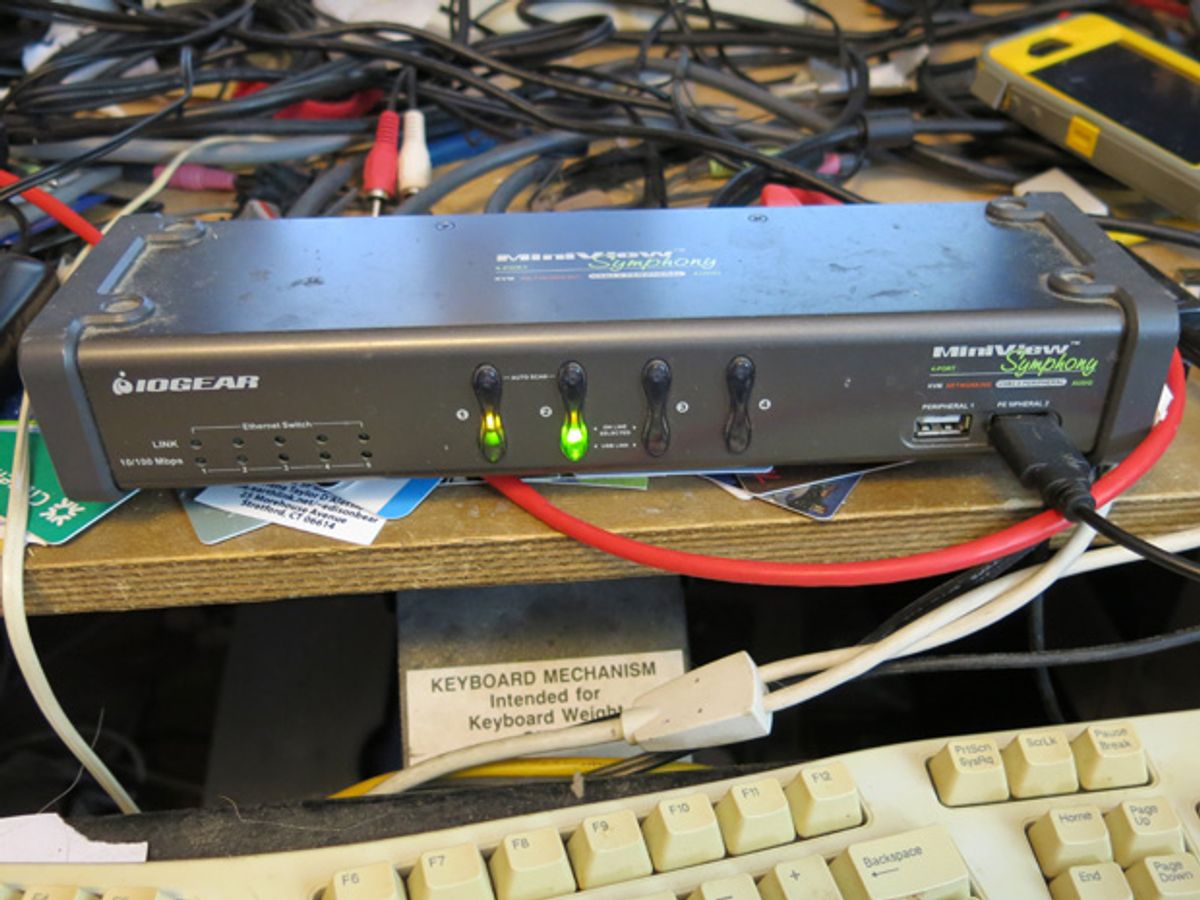
Like many readers of this publication, I’ve got more than one computer at my desk. But I don’t want the additional clutter—and ergonomic disaster—of having a separate display, keyboard, and mouse for each system. Nor do I want to be constantly unplugging and replugging the monitor, keyboard, and mouse cables every time I want to use a different computer.
Fortunately, there are two easy solutions: One involves hardware (keyboard-video-mouse, or KVM, switches) and the other involves software (remote-access programs. Both approaches are decades old, but a new generation of products is keeping pace with the demands of computers and peripherals that go way beyond those of an early-generation PC and a VGA monitor.
KVM Switches
A KVM switch lets you select which computer your input/output peripherals connect to. In the old days, this often literally meant just the keyboard, monitor, and the mouse, which you’d typically switch between two to four computers. Modern KVMs may also accommodate audio in and out, and some, known as KVMP switches—the P stands for “peripheral”—have front-side USB ports for printers, storage, scanners, and the like. Another difference is that KVMs once relied on mechanical switches, which could cause computer-damaging static leaks. Modern KVMs are electronic, which eliminates this concern.
Some KVMs can connect up to 32 computers, although these monsters are designed for data centers, connecting via the local network rather than with KVM-to-computer cables. Most desktop models top out at eight ports, such as IOgear’s eight-port USB DVI KVMP switch. KVMs often now include high-resolution support (2560 by 1600), and DVI (digital video interface) and HDMI (high-definition multimedia) video ports, but check the specs closely to make sure they can support the resolution you want to work at.
Pricewise, desktop KVMs run the gamut, from under US $50 to over $1,000. A four-port switch is likely to run you somewhere between $50 and $300, depending on what features you need. (Be sure to check whether that price includes the cables; since they’re typically nonstandard, four sets for a four-port KVM can easily bump the total price by another hundred bucks or so.) For example, there’s the Belkin two-port Flip PS/2 KVM ($40), which you can hold in your hand. The four-port IOgear Miniview Symphony GCS1774 ($250), which I’ve been using for more than four years, includes two USB peripheral ports and even a five-port Ethernet switch, and it measures a modest 27 by 8.9 by 5.6 centimeters. The device sits centered at the front edge of my desk, where I can easily reach the selection buttons and the USB peripheral ports.
Remote Access
Or you can do it all with software. Remote-desktop programs, like KVMs, let you connect your primary computer (the one you’re working on) to another computer. They give you a window on your primary display that shows what’s on the remote system’s display. When this window is your “foreground” app, you can control it with your keyboard and mouse. Of course, this means you’ll need to install the appropriate software on both computers. Depending on the software, you can also listen to audio, and access peripherals connected to the other machine’s ports. Some remote-access programs support printing, allowing you to print a file from the remote machine on your local printer, and do machine-to-machine file transfers.
Today, all desktop operating systems include at least one basic remote-access program. Windows has Microsoft’s Remote Desktop Connection; most Unix-based operating systems, such as Linux and OS X, include the command-line-based Telnet and SSH network utilities. More advanced versions are also offered by OS makers, such as the Apple Remote Desktop package ($80).
And there there’s no shortage of free, shareware, and commercial third-party remote-desktop apps and Web-based services, like GoToMyPC, Laplink Everywhere, LogMeIn, PuTTy, TeamViewer (which I’ve been using extensively over the past year), and VNC. (Note that some Windows Telnet/SSH apps—for example, the free PuTTY Windows client (https://www.putty.org)—aren’t “true” Windows apps, meaning that clicking on a hyperlink won’t open Firefox or some other browser.)
Remote-access client software is also available for mobile devices, allowing tablet users, for example, to access programs and data on their home or office desktop-OS machines. LogMeIn, GoToMyPC, Laplink, and others offer iOS and Android applications that provide partial to complete remote access.
I use both KVM switch hardware and remote-access software, depending on my needs. Not only is remote access good for switching between systems, it also lets you use two or more systems concurrently—for instance, if you want to listen to Pandora on one computer while using applications on another. (Using another computer for recreational Internet is a good way to keep cookies, viruses, and malware off your primary machine.) You can also move among windows faster than you can with a KVM, to copy and paste from one system to another, for instance.
KVM switches, on the other hand, are what you need when you just want to crank up one machine at a time, or when a machine isn’t getting far enough along in the boot process to run the remote-access software. Also, remote access adds noticeable latency—not good for games or VoIP calls—and may not render the screen well enough for precise graphic or video work (or gaming).
About the Author
Daniel P. Dern is a Boston-based freelance technology and business writer. He also writes science fiction. His last article for IEEE Spectrum was a roundup of summer science fiction reading for engineers.
Daniel P. Dern is a freelance journalist. He writes about the careers of engineers as well as a variety of technology topics.



